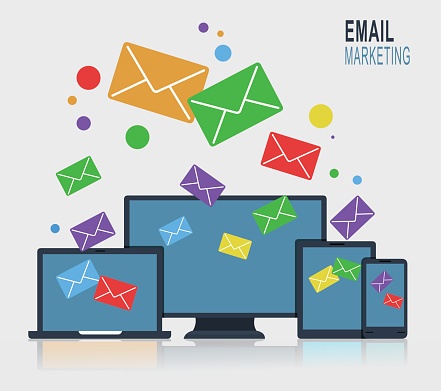 With all of the new technology that exists in marketing nowadays, it’s easy to overlook one of the most effective marketing tools around: email. While many have passed email off as outdated and on its way out, an email marketing strategy is more important than ever – in fact, 76 percent of marketers say they use email more now than they did three years ago.
With all of the new technology that exists in marketing nowadays, it’s easy to overlook one of the most effective marketing tools around: email. While many have passed email off as outdated and on its way out, an email marketing strategy is more important than ever – in fact, 76 percent of marketers say they use email more now than they did three years ago.
About 4.3 billion people have email accounts and send 196 billion emails every day. Of these, 91 percent check their email every day, and 77 percent of people say that email is their preferred channel for marketing communication. What’s more, email has an ROI of 4300 percent; for every dollar spent on email, you can expect $43 back (Source: Entrepreneur.com).
One-to-one, personal communication
Email is one of the most personal forms of marketing communication available because it's a channel you control. You maintain a one-to-one relationship with everyone you interact with through email, and can personalize it to the recipient at will. This means that email is particularly useful for the Close stage of the inbound methodology, converting leads to customers and possibly delighting them to become promoters.
Email is important for nurturing your audience. Through useful content and effective strategies, you can establish yourself as a beneficial source for your prospects, helping them grow as consumers or businesses. However, ineffective use of email can be perceived as spammy and off-putting. This is why it’s important to use certain best practices to make sure you send the right email at the right time. Remember the inbound philosophy: it’s all about the perfect union of context and content.
Target your emails for success
To ensure your emails are having the best impact, it’s important to determine your audience and segment your contacts effectively. Some ways to segment your audience can be geographically, such as by time zone to make sure your email is timed effectively, company size for businesses, position or status for individuals, or behavior such as click rate if you have access to the technology.
Remember to use your buyer personas when segmenting as well! Consider at what stage your buyer persona is at and adjust your content accordingly. For example, if they are at the Awareness stage, videos, blog posts, and free offers such as ebooks are your best bet. Estimates, offers for purchases, and any commitment is better suited for the Decision stage; these emails might lead people at an earlier stage to unsubscribe, meaning you effectively lost them as a lead.
It’s also important to adjust for mobile users, as 47 percent of all emails are opened on mobile devices. Be sure to use responsive templates and avoid small fonts. It’s unlikely that someone will respond well to an email that doesn’t work on their phone. Be sure to use clear and concise messaging as well. Actionable language and clearly defined goals are key in emails.
Analyze frequently and thoroughly
Be sure to analyze the effectiveness of your email marketing strategy. Delivery rate is a key metric to analyze – are your emails even reaching your target? Check for hard and soft bounces; the former means you’re sending to dead, inactive email addresses while the latter means your emails are going to a spam folder. You can check the open rate, but note this only shows the effectiveness of your subject line, not your content. For that, it’s best to analyze the click rate on the links and offers in your email.
Email marketing isn't going anywhere anytime soon - in fact, it's more important now than ever before. If you'd like to learn more, contact us at Half a Bubble Out.
 Since 2002, Half a Bubble Out has been dedicated to providing marketing, advertising and small business consulting that meet the needs of our clients. We specialize in powerfully telling stories through Inbound Marketing to grow your business filled with more passion and provision. Based in Chico California, we serve clients throughout Northern California and across the country to New York.
Since 2002, Half a Bubble Out has been dedicated to providing marketing, advertising and small business consulting that meet the needs of our clients. We specialize in powerfully telling stories through Inbound Marketing to grow your business filled with more passion and provision. Based in Chico California, we serve clients throughout Northern California and across the country to New York.


